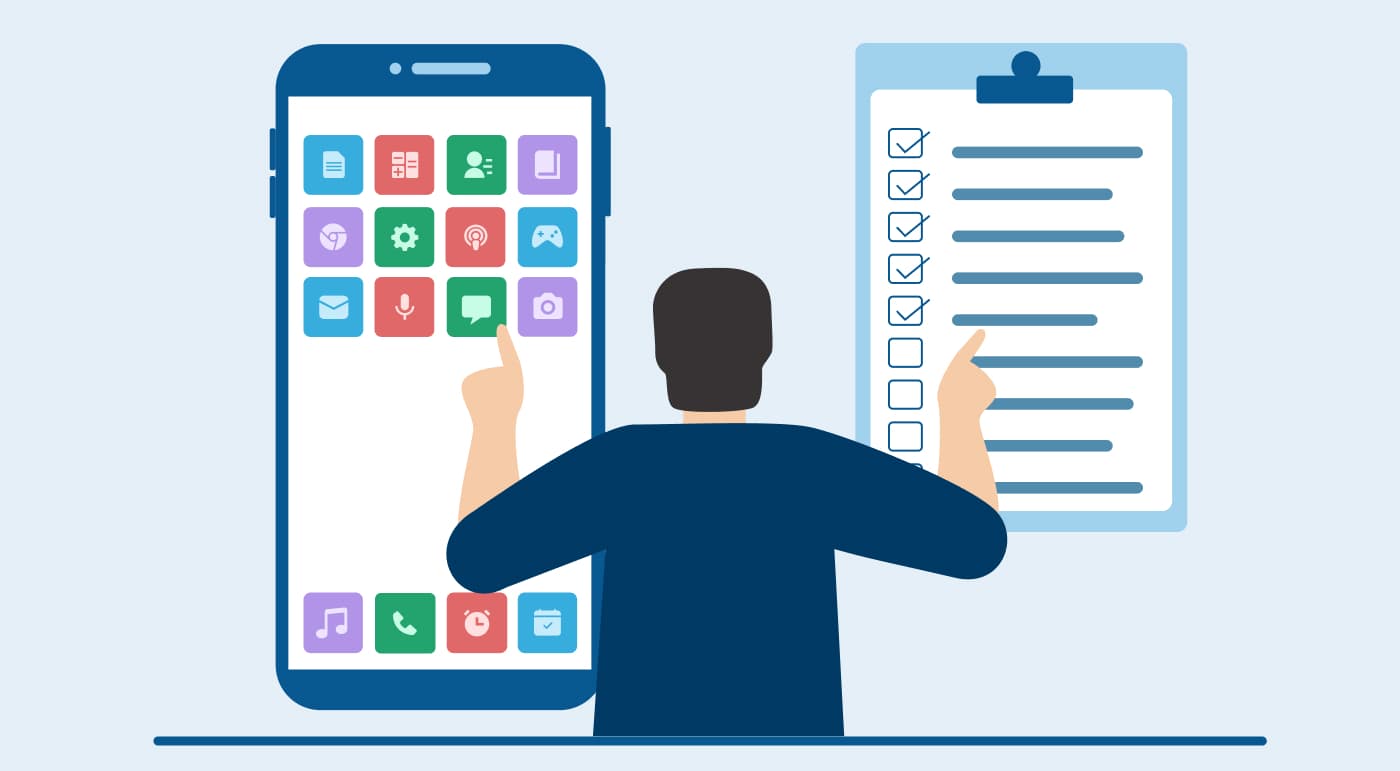What You Need to Prepare For to Create an App
September 1, 2022
Alex Shubin | Founder & CEO at SDA

What's the benefit of a mobile app design before its creation? As a rule, creating a complex project by intuition turns it into an endless long-term construction with unpredictable exits in unnecessary iterations, unwanted actions, and the blind spot between the customer and developer teams.
On the contrary, a well-conducted design stage will let you see a transparent picture of the forthcoming work in its entirety and not go blindly. However, with a mutually clear understanding of what, why and for whom it's being done, how long it'll take, and what's the amount of investment required.
Stages of creating a mobile app
Once you've decided on the basic concept of your future app, it's time to turn to a development contractor. What stages of work await you, what do you have to do, and what to get? Let's conveniently classify the independent app creation into four stages: preparation, development, launch and testing, promotion and support.
1. Preparation
At this stage, you're to decide for whom, why, and how the app will be developed. All this information needs to be collected in one document. It'll be the foothold for all participants in the process.
- The first and most significant thing is the choice of a contractor. It's a very influential stage because, among the many offers on the market, you need to choose one company with experience, approach and values that will impress you. And you'll be able to cooperate fruitfully. Don't rush to pick. Study all offers carefully and accurately compare. Don't be afraid to ask potential partners for information. As a result, you'll find a company with which you can comfortably cooperate and get an excellent result.
Market research. This stage isn't offered in all companies, but we prefer to conduct it to get an accurate assessment and idea of what we're developing the product for.
For whom? We determine the target audience – for whom we create the app.
What for? We describe what problem the target audience has and how the app will solve it. From here it follows – what's the benefit for the company from the app? Realizing for whom and why you're making the app is critical. Without understanding, there'll be no real benefit. It means that the app won't be used.
What do others have? Competitive analysis is a mandatory stage of preparation. Analyze what similar mobile apps are in the market. Try the most popular ones: note what's convenient and inconvenient, what's missing, and what features are outstanding. It's also helpful to look at the reviews. They can be found directly on the application page in the market or on Google.
What then? It's an optional step but a useful one. Think about how the app will fit into your overall promotion ecosystem, what chances it has for development, and whether you have the forces, time and money for support.
- Strategy formation. It's necessary to think about further development and product promotion immediately because it's urgent to lay some tools for this at the initial stage of development. As a result, you get a detailed roadmap of your product, which will help you move in the right direction and coordinate all actions accordingly.
- The result of the preparation is a fully prepared description of the future app with the target audience, functionality and business requirements.
2. Development
At this stage, you're to start thinking ahead about all details and functions of your app. Also, you need to visualize this app with UI/UX designers and begin the first steps of the app building with developers.
Prototyping. Here the development team creates a schematic prototype of the future app to think through and consider all the elements and their interactions. This stage helps to see the broad picture of the new app and evaluate its usability and viability in general.
Here you better concentrate on the problem of the target audience that you identified in the previous step. Based on this, describe a list of main functions. Then assemble them into a typical application script.
For this, the story frame method comes in handy: these are draft screens that your application will consist of. They contain nothing but text. Roughly speaking, it's a dialogue between the user and the app: the application offers – the user reacts – the app responds, and so on.
At this stage, the logic emerges: how many screens will be needed, what they'll be, what's better to combine or divide, where just text is required, and where an illustration is necessary. And already based on story frames, you'll build the final screens of your app. You don’t have to change the logic on the fly and make sweeping changes.
- Design. At this stage, visual solutions for the app are created according to all your requirements. The UI/UX designer builds the logic of interaction between the registration pages and authorization screens, data filling, personal account, and so on. The designer also develops the appearance of the future service following the terms of reference and corporate identity: selects a color scheme, fonts, draws icons, buttons, push notifications, sliders, etc.
And finally, the development itself. Programmers create the client and server part of the program, integrate all the necessary services and assemble the program together. One of the labor-intensive stages includes architecture elaboration and writing code. And it's divided into Back-end and Front-end development. Mobile developers must know the project concept, its uniqueness and be included in all processes to assess the idea viability and realize the customer's wishes.
Here Front-end programmers develop a thoughtful and tested client interface and platform logic. Back-end developers create a server to store and exchange information. Specialists prefer a programming language for writing code, hosting the server and API, and they build a database management system. The better the parameters are chosen, the faster the app will run.
The result of development is the first working version of the application or so-called MVP.

3. Launch and testing
In the third stage, you'll have to test your app during its creation process and prepare it for release.
The first phase here is testing. It rarely starts after development. More often, it's done in parallel, beginning with the formation of a strategy to make sure how the product works at each stage. The sooner you start testing, the more you can save. However, a mistake in the early stages of development is several times cheaper than before the release, no matter how paradoxical it may sound.
Before you deploy the app release to the public, you need to test it and fix all the bugs and errors found in the logic. The easiest option is to install it on the team's phones and actively use it for at least a few days. It's best to involve a focus group – people from outside who fit the description of the target audience and aren't yet familiar with the project. Beta testing is always a good tactic.
Don't leave testing until the last minute. If serious issues are discovered, the release date will be pushed back, which can cost you time and money. It's preferably to take a few weeks for testing – let it go through in a deep and calm mode, and you'll definitely have time to debug before the release than to receive negative reviews on the page every hour after publishing in the store. In this regard, it's always better to trust the experts. After all, based on experience, we can say exactly what and when it's better to test.
- Launch. When the product is ready, tested and, if necessary, improved, it can be brought to the market, uploaded to the app stores and started to be promoted as planned. Most importantly, before launching, it's essential to carefully study the Google Play Store and Apple App Store rules and prepare page screenshots, a marketing plan and a description. After downloading, the stores scan all the information and the project relevance. And they give a conclusion: whether they publish this app or not. If the implementation goes off without a hitch, it'll be available for download in a few days.
The result of the launch and testing is a beta version of the app, tested on a group of users.
Beta version is the intensive use of an almost finished version of the product to identify the maximum number of errors in its operation for their subsequent elimination before the final product release to the market and the mass consumer. These are newer, experimental versions of apps already available in the public domain.
4. Promotion and support
At the last but significant stage, you're to prepare an advertisement for your app and provide the needed technical support to develop the application and always make it better.
Promotion. Even before the launch, it would be good to announce the release and attract attention and interest in the future app. And when the finished tested app is ready, it can also be launched in advertising. Offer the app to site visitors, announce its release on social networks and make mailings to the base of regular customers. Upload to the app store – Google Play or App Store.
Beyond just an app, it's good practice to have one landing page or even more. Landing pages have become a must-have marketing solution for any kind of business. It isn't enough just to make a website and breathe easy. Of course, websites are necessary, they form the first impression of your brand, but landing pages are part of this impression. In some cases, they work even more efficiently.
The next phase is support and further development. We provide technical support to our customers because the initial stage of active work with the app is always complex, and questions or problems may arise. Having made the first app launch is far from everything, and it's meaningful to understand this. You need to properly analyze the first release and collect the first feedback to improve your app even more. Also it's obligatory to refine new functions, add features and monitor compliance with user expectations.
After the launch, you'll be able to analyze which sections are the most well-liked and which aren't very popular, how many people have completed the target actions, and which pages should be improved. Carefully study and process all incoming data; they will help refine the app and remove unnecessary functions. The analytics process is almost endless, so you'll need technical support to fix and quickly resolve current difficulties, optimize the app and give it another brush.
The result of promotion and support is the app has entered the market. It's often necessary and rightly so to support and develop it.
Below you can find a checklist you need to do to build an app:
- choice of a contractor;
- market research;
- strategy formation;
- prototyping;
- design;
- development;
- testing;
- launch;
- promotion;
- support;
- further development.
As you can see, the stages of developing a mobile app are logical and understandable. A good plan and following the development stages will help you save time and money when creating a mobile app.
The described stages are a classic version of the development process. However, we always discuss this process with each new client because it's noteworthy for us to synchronize with the customer and make the development process convenient and understandable. We can meet the individual client's needs and provide totally any service separately.
If you decide that you need a mobile app, think again. Will it solve your future user's problems? Do you really want to create an effective, high-quality and profitable app? Does it have something that no other existing product has? Are there enough forces and means to release the first version in order to collect investments later? Are you ready to promote and support it?
If you have any doubts or questions, write to us. We'll share our experience and knowledge and definitely help you.
